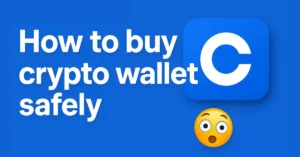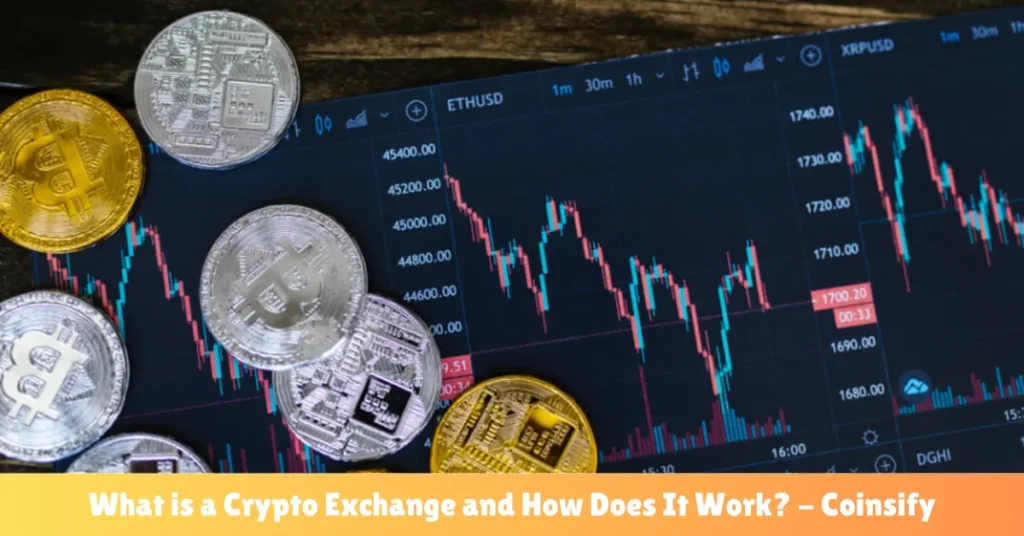What is a Crypto Exchange and How Does It Work:
Introduction
In recent years, you may have heard a lot about cryptocurrencies like Bitcoin, Ethereum, or Dogecoin. But how do people buy and sell these digital coins? The answer is simple: through something called a crypto exchange.
A crypto exchange is an online platform where you can trade cryptocurrencies, just like people trade stocks or currencies. If you’re new to this world, the idea might sound confusing, but don’t worry. In this blog, we’ll explain everything clearly and easily. You’ll learn what a crypto exchange is, how it works, and what to look for when choosing one.
Whether you’re thinking about investing in crypto or just want to understand how it all works, this guide is the perfect starting point.
What is a Crypto Exchange?

A crypto exchange is a website or app that allows people to buy, sell, or trade cryptocurrencies. Think of it like a marketplace—just like how you use a stock exchange to trade company shares, you use a crypto exchange to trade digital currencies like Bitcoin, Ethereum, or others.
Some exchanges also let you trade crypto for regular money (like dollars or rupees), and vice versa. Others only allow trading between different cryptocurrencies.
Crypto exchanges make it easier for both beginners and experienced users to get involved in the crypto world. They handle the transactions, provide live prices, and offer tools to help users manage their digital assets safely and efficiently.
Types of Crypto Exchanges
There are different types of crypto exchanges, and each one works in its way. Understanding the differences can help you choose the right platform for your needs. Here are the three main types:
Centralized Exchanges (CEX)
These are the most common and beginner-friendly platforms. A centralized exchange is run by a company that manages your account, handles the transactions, and provides customer support.
How it works:
- You create an account, deposit your money or crypto, and the exchange takes care of the rest. It acts as a middleman between buyers and sellers.
Examples: Binance, Coinbase, Kraken.
Pros:
- Easy to use
- High trading volume (liquidity)
- Customer support available
Cons:
- Your funds are held by the exchange
- Can be targets for hackers
Decentralized Exchanges (DEX)
These platforms don’t have a central company or authority in charge. Instead, they run on blockchain technology and allow users to trade directly with each other using smart contracts.
How it works:
- You connect your crypto wallet and trade directly without giving control of your funds to the exchange.
Examples: Uniswap, PancakeSwap, SushiSwap.
Pros:
- You control your funds
- More privacy
- Lower risk of exchange hacks
Cons:
- Less beginner-friendly
- Fewer trading options
- Slower transactions
Hybrid Exchanges
These exchanges try to combine the best of both worlds—offering the speed and features of centralized exchanges with the security and privacy of decentralized ones.
How it works:
- They use centralized systems for trading but allow users to control their funds through private wallets.
Examples: Qurrex, Nash.
Pros:
- Balanced features
- More user control
- Improved security
Cons:
- Still developing
- Not as widely used as CEX or DEX
How Does a Crypto Exchange Work?
A crypto exchange works like an online trading platform where people can exchange one currency for another, either crypto to crypto or crypto to traditional money. Here’s a step-by-step look at how the process usually works:
Create an Account
To start using a crypto exchange, you first need to sign up. This usually involves:
- Entering your email and password
- Verifying your identity (especially on centralized exchanges)
- Enabling extra security like Two-Factor Authentication (2FA)
This process helps keep your account secure and meets legal requirements like KYC (Know Your Customer).
Deposit Funds
Once your account is ready, you need to add money to it. You can usually deposit:
- Fiat currency (like USD, EUR, or PKR) via bank transfer, credit card, or e-wallets
- Cryptocurrency by transferred from another wallet
- The money will be added to your exchange wallet, ready for trading.
Place an Order
Now you’re ready to trade. There are two main types of orders:
- Market Order: Buys or sells instantly at the current price
- Limit Order: Sets a specific price at which you want to buy or sell; the trade happens only when the price matches
You choose the cryptocurrency you want to trade, enter the amount, and place your order.
Order Matching and Execution
The exchange uses its system to match buyers with sellers. Once a match is found, the trade is automatically completed.
Example: If you want to buy Bitcoin at $30,000 and someone is selling it at that price, the exchange matches your orders and completes the trade.
Withdraw Funds
After trading, you can:
- Keep your crypto in the exchange wallet
- Withdraw it to a private wallet for more security
- Convert it back to fiat money and withdraw it to your bank account
Always remember: for better security, it’s a good idea to move your crypto to a private wallet if you’re not planning to trade often.
Key Features of a Good Crypto Exchange
Not all crypto exchanges are the same. Some are built for beginners, while others are designed for experienced traders. So, what should you look for when choosing a good crypto exchange? Here are some important features to consider:
User-Friendly Interface
A simple and clean layout is very important, especially for beginners. A good exchange should be easy to navigate, making it simple to check prices, place trades, and manage your account.
Strong Security Measures
Security should be your top priority. A reliable exchange offers:
- Two-Factor Authentication (2FA)
- Encryption for user data
- Cold storage for most funds
- Regular security audits
These features help protect your money and personal information from hackers.
High Liquidity
Liquidity means how quickly you can buy or sell an asset without affecting its price. A high-liquidity exchange has more active users and trading volume, so your orders are filled faster and at better prices.
Wide Range of Cryptocurrencies
A good exchange supports a variety of coins and tokens, not just Bitcoin and Ethereum. This gives you more options to invest, trade, or diversify your portfolio.
Low and Transparent Fees
Check the exchange’s fee structure before signing up. A good exchange offers competitive trading fees, no hidden charges, and clear information about deposit/withdrawal costs.
Fast Transaction Speed
Whether you’re placing a trade or withdrawing funds, speed matters. Choose a platform that processes transactions quickly and efficiently.
Reliable Customer Support
Good customer service is crucial, especially if you run into issues. Look for exchanges that offer:
- 24/7 live chat or email support
- Help centers or FAQs
- Fast response times
Mobile App Availability
A mobile app lets you trade on the go. A good exchange offers a secure and well-designed app that works smoothly on both Android and iOS.
By keeping these features in mind, you can find an exchange that fits your needs, keeps your assets safe, and makes trading a smooth experience.
Security Measures to Consider

When dealing with cryptocurrencies, security is everything. Because crypto transactions are mostly irreversible and exchanges can be targets for hackers, it’s important to choose an exchange that takes your security seriously. Here are some key security measures to look out for:
Two-Factor Authentication (2FA)
- This adds an extra layer of security to your account. Besides your password, you’ll need to enter a code sent to your phone or generated by an app like Google Authenticator. This makes it much harder for hackers to access your account.
Cold Wallet Storage
- A good exchange stores most of its users’ funds in cold wallets, which are offline and not connected to the internet. This reduces the risk of large-scale hacks since cold wallets are harder to access remotely.
Secure Socket Layer (SSL) Encryption
- SSL encryption ensures that all the data you send to and receive from the exchange is encrypted. This helps protect your personal and financial information from being intercepted by third parties.
KYC (Know Your Customer) Verification
- While some people prefer anonymity, KYC processes add a layer of security by verifying users’ identities. This helps prevent fraud, money laundering, and unauthorized access.
Withdrawal Whitelists
- Some exchanges allow you to set up a withdrawal whitelist, which means funds can only be sent to pre-approved wallet addresses. Even if someone hacks your account, they won’t be able to steal your crypto without access to these approved addresses.
Anti-Phishing Codes
- Many exchanges let you set up a personal security code that appears in all official emails from them. This helps you recognize real emails from phishing scams trying to steal your login details.
Insurance Fund
- Some top exchanges offer insurance coverage in case of a hack or major loss. While this doesn’t cover all situations, it adds a level of confidence and protection for users.
Regular Security Audits
- Reputable exchanges perform regular internal and third-party audits to find and fix vulnerabilities in their system.
Tip: Even if the exchange is secure, always take responsibility for your safety:
- Use a strong, unique password
- Avoid using public Wi-Fi when logging in
Move large amounts of crypto to your wallet for added safety
Fees and Charges
When using a crypto exchange, it’s important to understand the different types of Fees and Charges involved. These costs can affect your profits, especially if you trade frequently. Let’s break down the common fees you might come across:
Trading Fees
These are the most common fees and are charged every time you buy or sell a cryptocurrency on the platform.
- Maker Fee: Charged when you place an order that isn’t filled immediately (you’re adding liquidity).
- Taker Fee: Charged when you match with an existing order (you’re taking liquidity).
Note: Some exchanges offer lower fees if you trade large volumes or use their native tokens (like BNB on Binance).
Deposit Fees
This fee may apply when you add money to your exchange account.
- Fiat Deposits (like USD or PKR): Can have small fees depending on the payment method (bank transfer, credit card, etc.).
- Crypto Deposits: Usually free, but this can vary by exchange.
Withdrawal Fees
Exchanges usually charge a flat fee or network fee when you withdraw crypto to an external wallet. This fee can change depending on the coin and the current blockchain traffic.
- Fiat Withdrawals: May have a fixed or percentage-based fee depending on the withdrawal method.
- Crypto Withdrawals: Charged per transaction based on network costs.
Spread
Some exchanges don’t show direct fees but make money through the spread—the difference between the buying price and the selling price. The wider the spread, the more the exchange earns, and the less favorable it is for you.
Inactivity Fees (Rare)
A few exchanges charge a small fee if your account stays inactive for a long time. Always read the platform’s terms to be sure.
Why It Matters
Even small fees can add up over time, especially for active traders. Always compare the fee structure of different exchanges before choosing one.
Tip: Look for platforms with transparent pricing and no hidden costs.
Popular Crypto Exchanges in the Market
With so many crypto exchanges available today, it can be hard to know which one to trust or use. Here are some of the most popular and widely used crypto exchanges around the world, each known for different strengths:
Binance
Binance is the world’s largest crypto exchange by trading volume. It offers a huge variety of cryptocurrencies and trading pairs. Binance is known for:
- Low trading fees
- Advanced trading tools for experienced users
- A user-friendly app and website
Coinbase
Coinbase is one of the most beginner-friendly exchanges, especially popular in the United States. It offers:
- Simple interface for buying and selling crypto
- Strong security features
- Educational resources for new users
Kraken
Kraken is known for its reliability and strong security. It’s favored by both beginners and professional traders. Features include:
- Wide range of coins and fiat options
- Low fees compared to many competitors
- High liquidity and fast transactions
KuCoin
KuCoin is popular for offering many altcoins (less common cryptocurrencies) and features like futures trading. It provides:
- Large variety of tokens
- User-friendly platform with advanced features
- Competitive fees
Bitstamp
One of the oldest crypto exchanges, Bitstamp, is known for its simplicity and regulatory compliance. It’s a good option for:
- Users looking for a trusted and regulated platform
- Easy fiat deposits and withdrawals
Choosing the Right Exchange
When choosing a crypto exchange, consider factors like your experience level, the coins you want to trade, fees, and security. These popular exchanges are a great starting point because they are well-established and trusted by millions of users.
Pros and Cons of Using Crypto Exchanges
Crypto exchanges have made it easier than ever to buy, sell, and trade digital currencies. However, like any financial platform, they come with both benefits and drawbacks. Let’s take a closer look:
✅ Pros
| Easy Access to Crypto Exchanges offer a simple way for beginners to get started with buying and selling cryptocurrencies without needing deep technical knowledge. |
| Wide Variety of Coins Most exchanges list multiple cryptocurrencies, allowing users to diversify their investments beyond just Bitcoin or Ethereum. |
| High Liquidity Popular exchanges have a large number of users, making it easier and faster to buy or sell assets at competitive prices. |
| Built-in Wallets Many exchanges offer built-in wallets where you can store your crypto temporarily, making it convenient for quick trades. |
| Trading Tools and Charts Advanced platforms offer tools like price charts, trading signals, and real-time data for more informed decision-making. |
| Customer Support Centralized exchanges usually provide customer service to help resolve issues related to deposits, withdrawals, or account access. |
❌ Cons
| Security Risks Exchanges can be targets for hackers. If the platform is not secure, your funds may be at risk, especially if you leave them in exchange wallets. |
| Centralized Control On centralized platforms, you don’t fully own your crypto until you transfer it to your wallet. The exchange controls your private keys. |
| Transaction Fees Trading, depositing, and withdrawing can come with various fees that may reduce your overall returns, especially for frequent traders. |
| Regulatory Issues Some exchanges may face legal challenges or restrictions in certain countries, which can affect your ability to use them. |
| Limited Privacy Most regulated exchanges require users to complete KYC (Know Your Customer) processes, which means sharing personal identification details. |
Bottom Line
Crypto exchanges are powerful tools that open the door to the world of digital assets. While they offer convenience and access, it’s important to be aware of the risks and take steps to protect yourself, like enabling security features and using personal wallets for long-term storage.
Frequently Asked Questions (FAQs
1. What is a crypto exchange in simple words?
A crypto exchange is an online platform where you can buy, sell, or trade cryptocurrencies like Bitcoin, Ethereum, and others. It works just like a stock exchange, but for digital money.
2. Is it safe to use a crypto exchange?
Yes, but only if you use a trusted exchange with strong security features like two-factor authentication (2FA), cold wallet storage, and encrypted data. Always use your own wallet for storing large amounts of crypto.
3. Do I need to verify my identity to use an exchange?
Most centralized exchanges require identity verification (called KYC – Know Your Customer) to follow legal rules and prevent fraud. Some decentralized exchanges don’t require it.
4. Can I use a crypto exchange on my mobile phone?
Yes! Most popular exchanges have mobile apps that let you trade and manage your account easily from your smartphone.
5. Are there any fees when using an exchange?
Yes, most exchanges charge fees for trading, depositing, or withdrawing crypto or fiat money. Always check the fee structure before using any platform.
6. What’s the difference between a centralized and decentralized exchange?
Centralized Exchange (CEX): Managed by a company. Easier to use but less private.
Decentralized Exchange (DEX): Lets you trade directly with others. More private but a bit harder for beginners.
7. Can I lose my money on a crypto exchange?
Yes, if the exchange gets hacked, shuts down, or if you fall for scams. That’s why it’s important to choose a trusted exchange and use strong passwords and security features.
8. Do I need a separate wallet to use an exchange?
No, most exchanges give you a built-in wallet. But it’s safer to transfer your crypto to a personal wallet if you’re not trading regularly.
9. How do I start trading on a crypto exchange?
- Create an account
- Verify your identity (if needed)
- Deposit money or crypto
- Choose a coin and place a trade
- Withdraw funds when needed
10. Which crypto exchange is best for beginners?
Coinbase, Binance, and Kraken are some of the most beginner-friendly platforms with simple interfaces and strong customer support.
Conclusion
Crypto exchanges play a key role in the world of digital currency. They make it possible for anyone, from beginners to experienced traders, to buy, sell, and manage cryptocurrencies with ease. Whether you’re using a centralized exchange for its simplicity or a decentralized one for more privacy, it’s important to choose a platform that matches your needs.
Before getting started, take time to understand how the exchange works, the fees involved, and the security measures in place. Always do your research, use strong security practices, and if you’re not trading often, store your crypto in a private wallet for extra safety.
With the right exchange and a bit of learning, you can confidently take your first steps into the exciting world of crypto trading.
Bonus Tips for Using Crypto Exchanges Safely and Effectively
Start Small
- If you’re new to crypto, don’t invest a large amount right away. Start with a small amount to understand how the exchange works and learn the basics of trading.
Use Strong Passwords
- Always use a unique and strong password for your Exchange account. Avoid using common words or personal information.
Enable Two-Factor Authentication (2FA)
- Turn on 2FA for extra account security. This adds an extra step (like a code from your phone) when logging in or making withdrawals.
Research Before Trading Any Coin
- Don’t buy a coin just because it’s trending. Always research the project, its use case, and the team behind it before investing.
Watch Out for Scams
- Be cautious of fake websites, social media giveaways, and phishing emails. Always double-check URLs and never share your private keys.
Learn Basic Market Terms
- Understanding terms like “market order,” “limit order,” “liquidity,” and “volatility” can help you make smarter trading decisions.
Stay Updated with News
- Crypto markets can be highly affected by global news. Follow trusted crypto news sources to stay informed about trends and regulations.
Don’t Leave Large Funds on Exchanges
- If you don’t plan to trade regularly, move your crypto to a private wallet. Exchanges are convenient, but wallets are more secure for storage.
Compare Fees Across Exchanges
- Fees can eat into your profits. Compare trading and withdrawal fees across different platforms to find the best deal.
Keep Learning
- The crypto world is always evolving. To stay ahead in the market, keep learning through blogs, tutorials, and videos.
Also read
- What is a Crypto Wallet and How Does It Work? – Coinsify
- 10 Crypto Terms Every Beginner Must Know – Coinsify
- What is Blockchain Technology – Complete Guide – Coinsify
- How to Buy Crypto Safely in 2025 – Complete Guide – Coinsify
- Bitcoin vs Ethereum: Key Differences Explained – Complete Guide
- Ultimate Blockchain Glossary: Learn Blockchain Terms Easily
- How to Buy Bitcoin Safely (Complete Beginner’s Guide)
- Top 10 Crypto Wallets for Beginners (2025 Edition)
- What is Cryptocurrency? A Beginner-Friendly Guide (2025)






